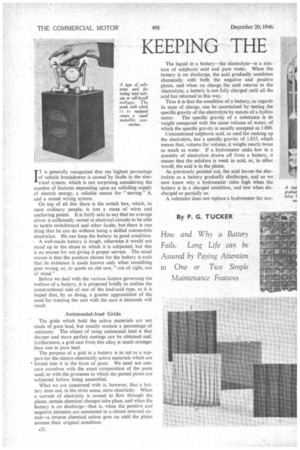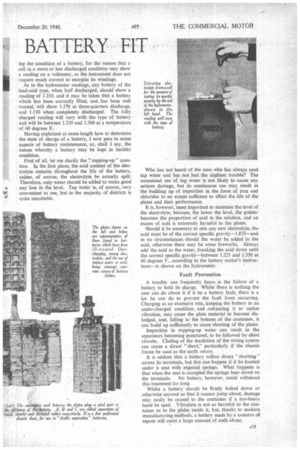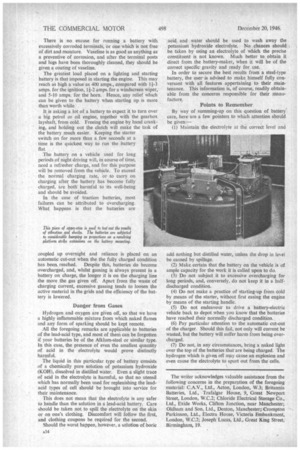KEEPING THE BATTERY FIT
Page 34

Page 35

Page 36

If you've noticed an error in this article please click here to report it so we can fix it.
Il is generally recognized that me highest percentage of vehicle breakdowns is caused 'by faults in the electrical system, which is not surprising considering the number of features depending upon an unfailing supply of electric energy, a reliable means for " storing " it, and a sound wiring system.
On top of all this there is the switch box, which, to most ordinary people, is just a maze of wires and anchoring points. It is fairly safe to say that no average driver is sufficiently versed in electrical circuits to be able to tackle switchboard and other faults; but there is one thing that he can do without being a skilled automobile electrician. He can keep the battery in good condition. . A well-made battery is tough, otherwise it would not stand up to the abuse to which it is subjected; but this is no excuse for not giving it proper service. The usual excuse is that the position chosen for the battery is such that its existence is made known only when something goes wrong, or, to quote an old saw, "out of sight, out of mind." .
Before we deal with the various factors governing the welfare of a battery, it is proposed briefly to outline the constructional side of one of the lead-acid type, as it is hoped that, by so doing, a greater appreciation of the need for treating the unit with the care it demands will result.
Antimonial-lead Grids The grids which hold the active materials are not made of pure lead, but usually contain a percentage of Antimony. The object of using antimonial lead is that sharper and more perfect castings can be obtained and, furthermore, a grid cast from this alloy is much stronger than one in pure lead.
The purpose of a grid in a battery is to act as a support for the electro-chemically active materials which are • forced into it in the form of paste. We need not concern ourselves with the exact composition of the paste used, or with the processes to which the pasted plates are subjected before being assembled.
What we are concerned with is, however, that a battery does not, in the strict sense, store electricity. When a current of electricity is caused to flow through the plates, certain chemical changes take place, and when the battery is on discharge—that is, when the positive and negative elements are connected to a closed external circuit—a reverse chemical action goes on until the plates assume their original condition.
A32 The liquid in a battery—the electrolyte—is a mixture of sulphuric acid and pure water. When the battery is on discharge, the acid gradually combines chemically with both the negative and positive plates, and when on charge the acid returns to the electrolyte; a battery is not fully charged until all the acid has returned in this way.
Thus it is that the condition of a battery, as regards its state of charge, can be ascertained by testing the specific gravity of the electrolyte by means of a hydro meter. The specific gravity of a substance is its weight compared with the same volume of water, of which the specific gravity is usually accepted as 1.000.
Concentrated sulphuric acid, as used for making up the electrolyte, has a specific gravity of 1.835, which means that, volume for volume, it weighs nearly twice as much as water. If a hydrometer sinks low in a quantity of electrolyte drawn off from a battery, it means that the solution is weak in acid, or, in other word, the acid is in the plates.
As previously pointed out, the acid leaves the electrolyte as a battery gradually discharges, and so we now know why a hydrometer rides high when the battery is in a charged condition, and low when discharged or partially so.
A voltmeter does not replace a hydrometer for test
ing the condition of a, battery, for the reason that a cell in a more or less discharged condition may show a reading on a voltmeter, as the instrument does not require much current to energize its windings.
As to the hydrometer readings, any battery of the lead-acid type, when half discharged, should show a reading of 1.210, and it may be taken that a battery which has been correctly filled, and has been well treated, will show 1.170 at three-quarters discharge, and 1.130 when completely discharged. The fully charged reading will vary with the type of battery and will be between 1.230 and 1.300 at a temperature of 60 degrees F.
Having explained at some length how to determine the state of charge of a battery, I now pass to some aspects of battery maintenance, or, shall I say, the means whereby a battery may be kept in healthy condition.
First of al!, let me clarify the "topping-up" question. In the first place, the acid content of the electrolyte remains throughout the life of the battery, unless, of course, the electrolyte be actually spilt. Therefore, only-water should be added to make good a any loss in the level. Tap water is, of course,. very convenient to use, but in the majority of districts is quite unsuitable. Who has not heard of the man who has always used tap water and has not had the slightest trouble? The occasional use of tap water is not likely to cause any serious damage, but its continuous use may result in the building up of impurities in the form of iron and chlorides to an extent sufficient to affect the life of the plates and their performance.
It is, however, most important to maintain the level of the electrolyte, because, the lower the level, the greater becomes the proportion of acid in the solution, and an excess of acid is extremely harmful to the plates.
Should it be necessary to mix any new electrolyte, the acid must be of the correct specific gravity—I.835—and in no circumstances should the water be added to the acid, otherwise there may be some fireworks. Always add the acid to the water, breaking the acid down until the correct specific gravity—between 1.225 and 1.350 at 60 degrees F., according to the battery maker's instructions—is shown on the hydrometer.
Fault Prevention A trouble one frequently hears is the failure of a battery to hold its charge. Whilst there is nothing the user can do about it if it be a battery fault, there is a lot he can do to prevent the fault from occurring. Charging at an excessive rate, keeping the battery in an under-charged condition, and .subjecting it to undue vibration, may cause the plate material to become dislodged, and, falling to the bottom of the container, it can build up sufficiently to cause shorting of the plates.
Impurities in topping-up water can result in the separators becoming punctured, to be followed by short circuits. , Chafing of the insulation of the wiring system can cause a direct "short," particularly if the chassis frame be used as the earth return.
It is seldom that a battery suffers direct" shorting" across its terminals, but this can happen if it be located under a seat with exposed springs. What happens is that when the seat is occupied the springs bear down on the terminals. No battery, however, could withstand this treatment for long.
Whilst a battery should be firmly bolted down or otherwise secured so that it cannot jump about, damage may easily be caused to the container if a too-heavy hand be qsecl. Vibration is not so harmful to the container as to the plates inside it, but, thanks to modern manufacturing methods, a battery made by a concern of repute will resist a large amount of such abuse.
There is no excuse for running a battery with excessively corroded terminals, or one which is not free of dirt and moisture. Vaseline is as good as anything as a preventive of corrosion, and after the terminal posts and lugs have been thoroughly cleaned, they should be given a coating of vaseline.
The greatest load placed on a lighting and starting battery is that imposed in starting the engine. This may reach as high a value as 400 amps., compared with 11-3 amps. for the ignition, 1-1-2 amps. for a windscreen wiper, and 5-10 amps. for the horn. Hence, any relief which can be given to the battery when starting up is more than worth while.
It is asking a lot of a battery to expect it to turn over a big petrol or oil engine, together with the gearbox layshaft, from cold. Freeing the engine by hand cranking, and holding out the clutch will make the task of the battery much easier. Keeping the starter switch on for more than a few seconds at a time is the quickest way to run the battery flat.
The battery on a vehicle used for long periods of night driving will, in course of time, need a refresher charge, and for this purpose will be removed from the vehicle. To exceed the =1'1-nal charging rate, Or to carry on charging after the battery has become fully charged, are bothharmful to its well-being and should be avoided.
In the case of traction batteries, most failures can be attributed to Overcharging. What happens is that the batteries are
coupled up overnight and reliance is placed on an automatic cut-out when the the fully charged condition has been, reached. Despite this, batteries do become overcharged, and, whilst gassing is always present in a battery on charge, the longer it is on the charging line the more the gas given off. Apart from the waste of charging current, excessive gassing tends to loosen the active material in the grids and the efficiency of the battery is lowered.
Danger from Gases Hydrogen and oxygen are given off, so that we have a highly inflammable mixture from which naked flames and any form of sparking should be kept remote.
All the foregoing remarks are applicable to batteries of the lead-acid type, and most of them can be forgotten if your batteries be of the AlkIum-steel or similar type. In this case, the presence of even the smallest quantity of acid in the electrolyte would prove distinctly harmful.
The liquid in this particular type of battery consists of a chemically pure solution of potassium hydroxide (KOH), dissolved in distilled water. Even a slight trace of acid in the electrolyte is harmful, so that no utensil which has normally been used for replenishing the leadacid types of cell should be brought into service for their maintenance.
This does not mean that the electrolyte is any safer to handle than the solution in a lead-acid battery. Care should be taken not to spill the electrolyte on the skin or on one's clothing. Discomfort will follow the first, and clothing coupons be required for the second.
Should the worst happen, however, a solution of boric acid, and water should be used to wash away the potassium hydroxide electrolyte. No chances should be taken by using an electrolyte of which the precise constituent is not known. Much better to obtain it direct from the battery-maker, when it will be of the correct specific gravity and ready for use.
In order to secure the best results from a steel-type battery, the user. is advised to make himself fully conversant with all features appertaining to their maintenance. This information is, of course, readily obtainable from the concerns responsible for their manufa ctu re.
Points to Remember By way of summing-up on this question of battery care, here are a few pointers to which attention should be given:— (1) Maintain the electrolyte at the correct level and
add nothing but distilled water, unless the drop in level be caused by spillage.
(2) Make certain that the battery on the vehicle is of ample capacity for the work it is called upon to do.
(3) Do not subject it to excessive overcharging for long periods, and, conversely, do not keep it in a halfdischarged condition.
(4) Do not make a practice of starting-up from cold by means of the starter, without first easing the engine by means of the. starting handle.
(5) Do not endeavour to drive a battery-electric vehicle back to depot when you know that the batteries have reached their normally discharged condition.
(6) Pay particular attention to the automatic cut-out of the charger. Should this fail, not only will current be wasted, but the battery will suffer harm from being overcharged.
(7) Do not, in any circumstances, bring a naked light over the top of the batteries that are being charged. The hydrogen which is given off may cause an explosion and even cause the electrolyte to spurt out from the cells_
The writer acknowledges valuable assistance from the following concerns in the preparation of the foregoing material: C.A.V., Ltd., Acton, London, W.3; Britannia Batteries, Ltd., Trafalgar House, 9, Great Newport Street, London, W.C.2; Chloride Electrical Storage Co., Ltd., Exide Works, Clifton Junction, near Manchester; Oldham and Son, Ltd., Denton, Manchester; Crompton Parkinson, Ltd., Electra House, Victoria Embankment, London, W.C.2; Joseph Lucas, Ltd., Great King Street, Birmingham, 19.




































































